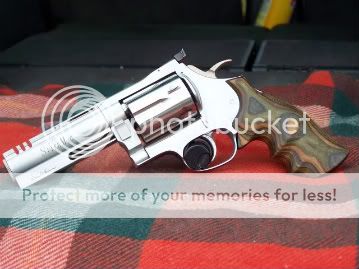August 28, 2014
 Offline
OfflineHi all,
I would like to first say "thanks" for the great info here, as my new-to-me Model 40 Supermag needed some input from the experts. A forum search helped me out the first time, but now I'm stumped.
While the 8-inch blued beauty came with an extra barrel in the styrofoam 'box', there was neither a barrel tool nor shim to be found. A quick look to the right column directed me to EWK, who fixed me up with everything needed in a very timely manner.
Upon attempted disassembly, it was obvious that the barrel nut had been partially stripped, and required the old "clamp" technique to release it. A thorough cleaning, a new barrel nut, a proper gapping and it was off to the races.
I received two boxes of Remington 158gr in the deal for the gun, and shooting the first box left a grin on my face for about a week. Deep in the throes of a home remodel, I possess neither the time nor space to start the whole reloading thing, and am currently at the mercy of commercial offerings or the occasional vintage score.
My other LGS was kind enough to source some Jameson 'Predator Grade' 158gr 357 MAX at a very fair price, and I was thrilled to own a small stash of the "correct" ammo for this fine revolver.
The next next rip to the range was quite a disappointment. The first cylinder of this new ammo required a cleaning rod to eject the spent brass, and five of the six cases were split from the neck roughly 3/4 of the way down !!! I put the gun aside, crestfallen, and continued the session with the other guns that had been brought along.
A quick examination of the gun reveals no apparent bulges, blockages, or carbon deposits that would indicate an obvious issue, so I throw myself on the mercy and collective knowledge of the DWF to help solve this upsetting mystery.
Thanks in advance ! Pics to follow.
Patriot X
August 28, 2014
 Offline
OfflineHere's a peek at the ammo/brass in question:
http://i1368.photobucket.com/albums/ag193/PatriotX/357maxbrass01_zpsde0bb34d.jpg
http://i1368.photobucket.com/albums/ag193/PatriotX/357maxbrass11_zpsbd4cc3a9.jpg
Supporter

Moderators

Dans Club
February 22, 2009
 Offline
OfflineMost likely a problem with the ammo. To start troubleshooting; what is the diameter of the fired and cracked cases vs the uncracked case vs the loaded ammo vs the chamber- you'll want to slug that with soft lead like a fishing weight for accuracy- lube it first and hammer it to the throat, then hammer it back out.
If everything is within .004" or so then it may be the brass wasn't annealed well. Either way, you may want to call them- there may be a known issue.
Regards, Ron
Technically, the glass is always full; half liquid, half air....
Supporter
Range Officer

Dans Club

Range Officers
Members
July 2, 2011
 Offline
OfflineInteresting when you look at the brass. The base of the cracks appear to be close to the same location on each casing and the pattern is very consistent. I haven't the faintest idea if that is symptomatic of anything, but I did find it interesting.
To the paranoid people who check behind shower curtains for murderers:
if you find one...what's your plan?
Supporter

Moderators

Dans Club
February 22, 2009
 Offline
OfflineI've seen similar with over sized chambers, usually with a wildcat chambering. I've also seen similar on work hardened cases but I doubt that's the issue if this is factory ammo. Some military surplus with steel cases will also do the same.
Technically, the glass is always full; half liquid, half air....
August 28, 2014
 Offline
Offlinebrucertx said
Interesting when you look at the brass. The base of the cracks appear to be close to the same location on each casing and the pattern is very consistent. I haven't the faintest idea if that is symptomatic of anything, but I did find it interesting.
That also struck me as odd.

Dans Club
May 17, 2009
 Offline
OfflineCan you pull one of the unfired rounds and weigh the powder. As you probably won't know what powder was used, you could check a load book to see if any loads are at the weight you have, or over the max for any powder. I've had some cases stick in the chamber in the past, but I knew they were "hot" as I reloaded them. Good luck.

August 15, 2014
 Offline
OfflineSlight primer flattening, but not anything out the ordinary for a warmer load. And primer reading isn't always a dependable indicator. Just guessing, but I'd go with an overload or a problem with the brass. Five out of six splitting ….Wow.
As Jaggman said, pull one down and weigh the powder charge. Or just put these rounds away and never use them.

Dans Club
April 18, 2014
 Offline
OfflineMaybe some pics of unfired cases as well, Patriot
Oath Keeper #021479 NRA #206814004
Member AAGSR Member AGA #83120600233
"To preserve liberty, it is essential that the whole body of the people always possess arms and be taught alike, especially when young, how to use them."
Richard Henry Lee
American Statesman, 1788
Supporter
Range Officer

Range Officers
May 2, 2009
 Offline
OfflineThat is in my opinion most definitely work hardened brass/poor annealing--really old brass shows the same splitting symptoms. That brass is almost crystalline on the edges. The splitting to the same location on each case is where the "web" of the case is (where it gets thicker at the bottom). It doesn't take much room in the cylinder for hard brass to split, especially at 357 max pressures.
You may want to do some research on the company and see where they are manufacturing their cases at. Cheap brass is very brittle and will exhibit same symptoms.
SHOOT
1 Guest(s)

 Register
Register Log In
Log In Home
Home




